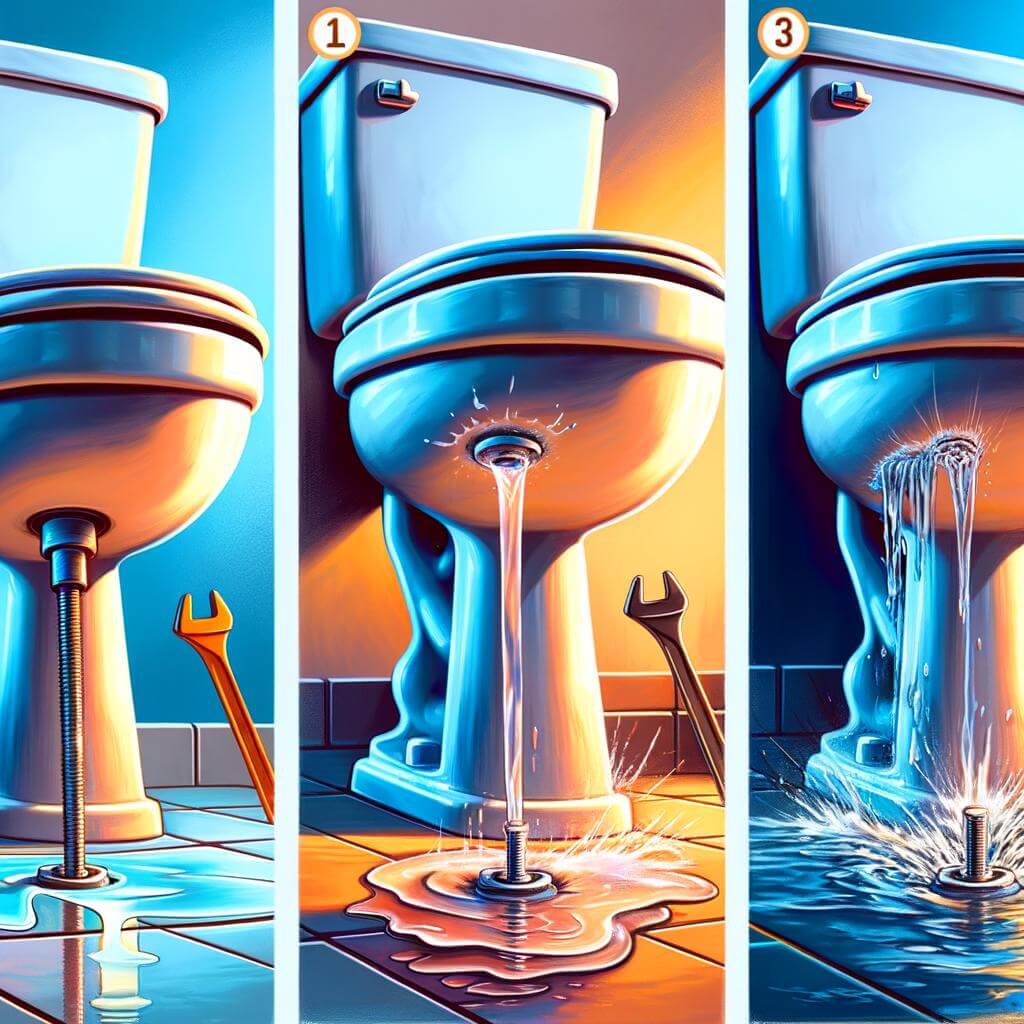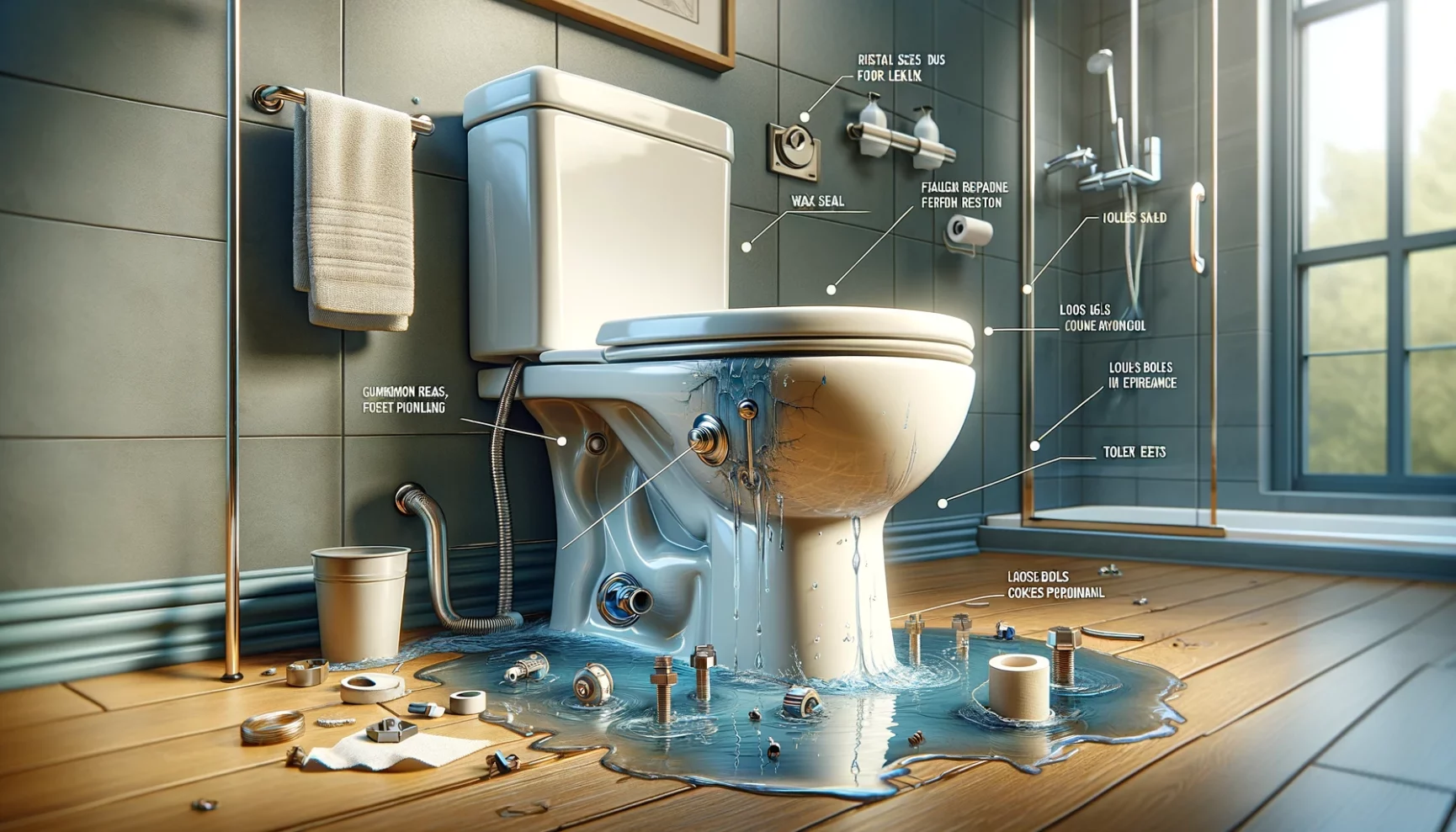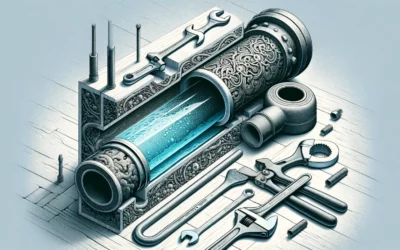IWelcome to our latest post, “Expert Insight: Key Reasons Why Your Toilet Leaks from Its Base.” This educational article is packed with expert opinions and facts aimed at helping you understand the common reasons behind an issue that can cause significant inconvenience: a leaking toilet. A leaking toilet is not only troublesome but can lead to significant water waste and potentially higher bills. By educating yourself about the potential causes, you put yourself in a better position to troubleshoot and resolve the problem when it arises. So, sit back, read on, and equip yourself with the knowledge to tackle this common household problem with confidence and ease.
Understanding the Common Causes of Toilet Leaks
Toilets are a prime spot for water leaks in most homes. However, most homeowners overlook them because they are silent and inconspicuous. A common leakage point occurs around the base, where the toilet meets the floor. Two primary reasons account for this: faulty wax seals and broken flanges.
The Wax Seal
Traditionally, a wax ring seals the base of the toilet. This seal prevents water from leaking as it passes from the toilet to the sewer pipe through the floor. Over time, the wax seal can deteriorate, become misaligned, or suffer damage from frequent use. When this happens, water can slip past and you have a leak on your hands. Essentially, whenever you observe water pooling around the base after flushing, a faulty wax seal is the likely culprit. You might also perceive a lingering odor due to the leakage of sewer gases.
The Flange
The flange’s role is similarly significant. It’s a pipe fitting that both mounts the toilet to the floor and connects it to the drain pipe. A flange needs to be in prime condition for the toilet to work properly. If it cracks or breaks, water will leak at the base. Factors often leading to flange damage include age, wear and tear, and improper installation.
| Common Cause | Impact |
|---|---|
| Faulty Wax Seal | Leads to water pooling around the base, causing water wastage and potential damage to flooring. |
| Broken Flange | Results in water leakage at the base, which can lead to structural damage over time. |
In conclusion, both a faulty wax seal and a broken flange are common reasons why your toilet might be leaking from its base. Regular inspection and maintenance can prevent these issues, saving you unwanted repair costs and conserving water in the process.
Deciphering Signs that Indicate a Leaking Toilet Base
Spotting the Early Warnings The first step towards solving any problem is identifying it on time, and a leaking toilet base is no exception. If your toilet is leaking from its base, you may notice wetness around the toilet area even when it hasn’t been used recently. In more severe cases, water may be visibly leaking from the base. Additionally, if the wax seal under the toilet is damaged, you may notice a strong, unpleasant odor. This is due to sewer gases escaping into your bathroom, so it’s a sign you should definitely not ignore. While some signs are more obvious, some subtle indications might be overlooked. Let us review these signs:
- Visible water pooling around the toilet base: This is the most obvious sign and usually the first to be noticed.
- Unusual odors: Sewer gas leakage could result in bad smells, appreciable near the toilet base.
- Distorted Flooring: If your bathroom floor near the toilet seems to warp or discolor, water leakage could be the culprit.
- Constant running water noise: A continuously running toilet could be due to leakage, resulting in repeated activation of the fill valve.
Understanding the Causes Once you’ve detected a leaking toilet base, it’s imperative to understand what might be causing it. The most common reason is a damaged or worn out wax ring seal, which prevents water from leaking out of the base. Another common reason is a loose toilet base. This can occur when the bolts securing the toilet to the floor have come loose. Lastly, you may be dealing with a cracked toilet bowl or tank. Even minor cracks can lead to significant leakage. Here is a brief table illustrating these causes:
| Leak Origin | Probable Cause |
| Wax Ring | Damage or wear and tear over time |
| Base Bolts | Loosening over time due to constant usage or initial improper installation |
| Toilet Bowl or Tank | Cracks which might develop from using harsh cleaners or mechanical impact |
While remediation for these conditions is not usually complex, it is always advisable to engage professional services to ensure effective and permanent fixes. After all, saving a few dollars now might lead to costly repairs in the future.
Crucial Role of Wax Ring in Toilet Leaks
A common cause of water leaking from the base of your toilet is a faulty wax ring. This doughnut-shaped seal is positioned between the floor and the bottom of the toilet to prevent leakage from the sewers up to the top of the bowl and onto the floor. It forms a waterproof seal that forestalls water and unpleasant odors from escaping and protects the floor from damage caused by constant exposure to water.
Over time, the wax ring may lose its ability to seal properly due to strain from use and temperature fluctuations. When this occurs, water starts leaking every time you flush. The signs are visible - you’ll notice a pool of water accumulated around the base of your toilet, and potentially, a foul smell. To fix this issue, you must replace the wax ring. Here are the steps:
- Remove the toilet: You need to lift the whole toilet to access the wax ring. Do this by disconnecting the water supply and removing the nuts holding the toilet in place.
- Take out the old wax ring: Use a putty knife or similar tool to scrape off the old ring. Make sure you remove it entirely to allow the new ring to seal effectively.
- Install the new wax ring: Position the new wax ring in the exact spot where the old one was. Carefully lower the toilet back into place, ensuring the screws match the holes in the toilet base.
- Reconnect the toilet: Replace the nuts and reconnect the water supply. Give it a test flush to confirm everything is in order and the leakage has stopped.
| Problem | Solution |
| Water leaking around toilet base | Replace wax ring |
Always remember, regular maintenance is crucial to prevent such leaks. Promptly replace the wax ring at the onset of a leak to save your floor from water damage and keep your bathroom clean and hygienic.

How a Loose Toilet Tank can Cause Base Leaks
Having a loose toilet tank is not just an annoyance, it can lead to more significant issues, such as leaking from the base of the toilet. As the tank shifts, it can strain the gasket seals between the tank and the bowl, as well as the wax ring seal between the toilet base and the floor. When these seals are strained or damaged, water can begin to leak from the base of the toilet. Depending on the severity of the leak, this could cause water damage to your floors and potentially even lead to structural issues if left unattended.
So how do you know if a loose toilet tank is causing your toilet to leak from its base? There are a few signs you can look out for. Excessive movement when you are using the toilet is a clear indication that the tank is loose. Another sign is water pooling around the base of the toilet. Finally, if the water level in the tank is consistently lower than the fill line, even when the toilet hasn’t been used, this could mean that water is leaking out through a damaged seal.
| Sign | What it Indicates |
|---|---|
| Excessive movement | Has a loose tank |
| Water pooling around the base | Possible leak from the bottom |
| Consistently low water level in tank | Leak through a damaged seal |
If you observe any of these signs, it’s crucial to address the issue promptly to prevent further damage. You may be able to tighten a loose tank yourself, but if water is already leaking, it’s usually a sign that the seals are damaged and need to be replaced. This is a task best left to professionals to ensure that it’s done correctly and to prevent further leaks in the future.
Reparing a toilet can be a messy job but just remember in the long run, prompt action can save your floors and your wallet from further damage yielded by a loose toilet tank.
Expert Tips to Fix a Leaky Toilet Base
In diagnosing the root cause of a leaky toilet base, there are several key factors to consider. A common culprit is the wax ring that seals the base of the toilet to the floor. Over time, this ring can degrade or become unseated, causing water to ooze out every time you flush. Replacing the wax ring is most times tested and proven to fix toilet leaks at the base. Another possible cause is cracks in the toilet base itself. While this is rarer, a crack – even a small one – could allow water to escape. In such cases, the solution usually involves replacing the entire toilet.
Below are practical steps to fix a leaky toilet base using professional tips:
- Shut off the water supply: Before you get to work, it’s essential to close the water valve to prevent any more water from entering the toilet.
- Empty the toilet: Flush the toilet to drain off the remaining water in the bowl and tank.
- Loosen the bolts: Carefully unbolt the toilet from the floor. Always be gentle to avoid breaking anything.
- Replace or reseat the wax ring: Lift the toilet and check the wax ring. If it’s damaged, replace it. If it’s off-centre, simply reposition it.
- Reassemble the toilet: Return the toilet to its original place, ensuring it aligns perfectly with the ring and the flange. Tighten the bolts, reconnect the water supply, and give it a test flush.
When assessing the condition of your toilet base, remember that even hairline cracks can be a problem. Look closely and run your hand over the outer surface to detect any pits or ridges. Replace the toilet if a crack is present. It may seem like a daunting task, but with the right tools and a bit of determination, you can successfully fix a leaky toilet base, saving money on expensive plumber call-outs in the process.

Preventive Measures to Avoid Toilet Base Leaks
Toilet leaks from the base often occur due to three significant issues: improper installation, worn-out wax seal, and cracked bowl. Fortunately, there are several easy preventive measures that every homeowner can take to avoid this problem.
Regular Maintenance is the key to preventing these types of leaks. Always inspect your toilet to ensure that it’s properly installed. If the toilet is wobbly, it can break the wax seal and lead to leaks. Therefore, always make sure to tighten the bolts that connect your toilet to the floor. However, be careful not to over-tighten, as it can crack the toilet base. Furthermore, if you spot any cracks in the toilet bowl during your regular inspections, it’s crucial to take immediate action. A minor crack can lead to a major leak if left untreated.
| Activity | Action |
|---|---|
| Regular Inspections | Check if the toilet is properly installed and look for any cracks in the bowl. |
| Proper Installation | Ensure the bolts that connect the toilet to the floor are tightened. |
| Immediate Repair | Fix any minor cracks instantly to prevent major leaks. |
Unarguably, the Wax Seal plays a crucial role in maintaining the integrity of a toilet’s base, it serves as a water barrier between the toilet base and the drain pipe. Overtime, and as a result of constant use, the wax ring can wear out and cause leaks. Therefore, regular replacement of the wax seal is advisable. Changing the wax ring is a straightforward job that any DIY enthusiast can handle; all you need is the right tools and a new wax ring.
Also, Re-Tiling a bathroom floor or installing a new toilet provides a prime opportunity to replace the wax seal and inspect the flange for damage. Remember, an intact flange is essential for the wax ring to make a good seal. If it’s cracked or broken, it’s worth having it replaced by a professional plumber. Don’t skimp on these two essential components; they are the backbone of a leak-free toilet.
| Activity | Benefit |
|---|---|
| Changing Wax Seal | Avoids leakage caused due to worn-out wax rings. |
| Re-Tiling or New Toilet Installation | Perfect time to replace the wax seal and inspect the flange for any damage. |

In-depth Analysis: The Long-term Consequences of Ignoring Toilet Leaks
Many homeowners overlook the occasional puddle of water around the toilet base, attributing it to frequent showers or humid weather. However, this seemingly inconspicuous issue harbors potentially significant long-term consequences. Structural damage, health problems caused by mold growth, and increased utility bills are among the adverse effects of ignoring even a minor toilet leak.
The water escaping from the toilet finds its way into the subfloor, weakening the structural integrity of the bathroom. Over time, these leaks can lead to substantial damage and hefty repair costs. Mold and mildew thrive in such damp conditions, leading to a musty smell and posing serious health risks.
- Structural damage: Over time, the water leaks weaken your home’s wooden structures, eventually leading to decay. This can compromise the strength and stability of the structure, demanding costly repairs and replacements.
- Health implications: The wet and warm conditions created by water leaks offer a perfect breeding ground for molds. Mold spores can cause allergies, skin irritations, and respiratory issues, especially in individuals with asthma or other respiratory complaints.
- Increased utility bills: A seemingly insignificant leak can waste up to 6,300 gallons of water per month, dramatically increasing your utility bills.
| Potential Consequences | Impact |
|---|---|
| Structural Damage | Increased repair and renovation costs |
| Health Implications | Allergies, skin irritations, respiratory issues |
| Increased Utility Bills | Hiked monthly water bills |
Hence, it is advisable to address any plumbing issues at the earliest. Surprisingly, some simple DIY solutions can effectively mitigate these problems. If the problem persists, do not hesitate to reach out to a professional plumber for an expert solution.

Smart Replacement Alternatives for Your Leaking Toilet
It’s alarming to walk into your bathroom and see a puddle around the base of your toilet. No, it’s not a spilled glass of water, or a missed shower spray, but a small, persistent leak. Don’t panic just yet, this issue is more common than you might think. Although you may be unnervingly close to a mild case of bathroom flooding, there are viable solutions for you. Here’s everything you need to know about why your toilet leaks, and how to smartly replace it when necessary.
When your toilet leaks from its base, the number one culprit is usually a broken wax ring seal. This unassuming component plays an essential role in making sure your toilet is watertight. A faulty seal can result from its age, improper installment, or even the settling of your house. Also, cracks in the base of the toilet itself can cause this problem, though this is less common. Revamping these parts of your toilet will make sure that the water stays where it’s supposed to be: inside the pipes. If the issue persists, it might be time for a new toilet.
Smart Replacement Alternatives
- Dual-Flush Toilets: They provide two different flush power levels. This feature not only prevents leakage but also saves on your water bill.
- Pressure-Assisted Toilets: These are powered by pressurized air instead of gravity. While they are a bit louder, they effectively prevent leaks.
- One-Piece Toilets: Built as a single unit, these toilets are less prone to leaks as they don’t have the junctions where two-piece toilets often fail.
| Type of Toilet | Main Features | Pros |
|---|---|---|
| Dual-Flush Toilets | Two flush power levels. | Prevents leakage, conserves water. |
| Pressure-Assisted Toilets | Powered by pressurized air. | Effectively prevents leaks, powerful flush. |
| One-Piece Toilets | Built as a single unit. | Less prone to leaks, easy to clean. |
Ultimately, the best toilet for your home will depend on your budget and cleanliness priorities. The most important thing is to ensure its proper installation and maintenance to prevent leaks in the future. Remember, an ounce of prevention is worth a gallon of mop water.
Professional Advice: When to Call a Plumber for Toilet Leaks
While discovering a trail of water leading away from your commode can be a startling experience, it’s important to remain calm and quickly determine the source of the leak. Toilet leaks at the base can be caused by several reasons; one common cause includes broken wax seals. The wax ring that seals the base of your toilet to the sewer pipe can harden and break over time, making it unable to perform its job efficiently. Another possibility is that your toilet flange may be broken. The flange is a circular pipe fitting that connects your toilet to the floor and when it breaks, you may find water seeping from under the toilet.
In certain cases, you can resolve simple leakage issues with DIY methods. However, there are situations when it’s best to call a professional to preserve the integrity of your plumbing system. For instance, when the leakage problem stems from complex issues such as a broken flange or wax ring, experts advise enlisting the help of a professional plumber. Moreover, if your toilet continually leaks even after replacing components like the flange or wax seal, it’s a clear sign you might need professional assistance. Ascertaining the root of the problem can be challenging for amateurs, and faulty DIY repairs can possibly worsen the problem.
| Issue | DIY Fix or Professional Help |
|---|---|
| Worn out Wax Seal | Potential DIY, but ideally Professional Help |
| Broken Toilet Flange | Professional Help |
| Consistent Leakage Post-Repair | Professional Help |
Keep in mind that the plumbing system of your home is a complex network of pipes and fittings. A leak can quickly escalate into more severe problems affecting your entire home’s plumbing. Remember, when in doubt, it’s safe to call a professional.
To Conclude
In conclusion, understanding the key reasons why your toilet leaks from its base can make issues less daunting and allow you to find a solution more promptly. As experts in the field, we can assure you that whether it’s a fault in the wax seal, a loose tank, defective bolts, or a cracked porcelain base, appropriate measures can be taken to resolve the problem. Keep in mind that regular maintenance and timely repairs are essential to preventing water damage and costlier fixes down the line. Don’t hesitate to reach out to a professional if you’re unsure about handling these issues yourself. Remember, you play an integral part in ensuring your home’s plumbing system works without causing any unwelcome surprises. With this essential knowledge, you can navigate those disconcerting toilet leaks and restore harmony to your home.










